| Listing 1 - 10 of 15 | << page >> |
Sort by
|
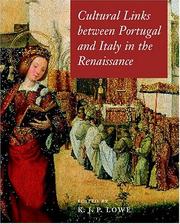
ISBN: 0198174284 Year: 2000 Publisher: New York Oxford University Press
Abstract | Keywords | Export | Availability | Bookmark
 Loading...
Loading...Choose an application
- Reference Manager
- EndNote
- RefWorks (Direct export to RefWorks)
History of civilization --- Art --- anno 1500-1599 --- Italy --- Portugal --- Arts [Italian ] --- Arts [Portuguese ] --- Arts italiens --- Arts portugais --- Kunsten [Italiaanse ] --- Kunsten [Portugese ] --- Art [Portuguese ] --- Arts [Renaissance ] --- Relations
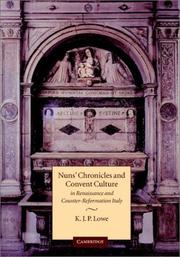
ISBN: 9780521621915 Year: 2003 Publisher: Cambridge Cambridge University Press
Abstract | Keywords | Export | Availability | Bookmark
 Loading...
Loading...Choose an application
- Reference Manager
- EndNote
- RefWorks (Direct export to RefWorks)
Christian spirituality --- Christian religious orders --- anno 1500-1599 --- Italy
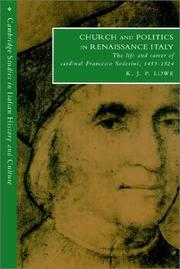
ISBN: 0521529352 Year: 1993 Publisher: Cambridge New York Cambridge University Press
Abstract | Keywords | Export | Availability | Bookmark
 Loading...
Loading...Choose an application
- Reference Manager
- EndNote
- RefWorks (Direct export to RefWorks)
Book
ISBN: 0691246890 9780691246895 9780691246840 Year: 2024 Publisher: Princeton, N.J. Princeton University Press
Abstract | Keywords | Export | Availability | Bookmark
 Loading...
Loading...Choose an application
- Reference Manager
- EndNote
- RefWorks (Direct export to RefWorks)
A thought-provoking study of how knowledge of provenance was not transferred with enslaved people and goods from the Portuguese trading empire to Renaissance Italy In the fifteenth and sixteenth centuries, Renaissance Italy received a bounty of "goods" from Portuguese trading voyages--fruits of empire that included luxury goods, exotic animals and even enslaved people. Many historians hold that this imperial "opening up" of the world transformed the way Europeans understood the global. In this book, K.J.P. Lowe challenges such an assumption, showing that Italians of this era cared more about the possession than the provenance of their newly acquired global goods. With three detailed case studies involving Florence and Rome, and drawing on unpublished archival material, Lowe documents the myriad occasions on which global knowledge became dissociated from overseas objects, animals and people. Fundamental aspects of these imperial imports, including place of origin and provenance, she shows, failed to survive the voyage and make landfall in Europe. Lowe suggests that there were compelling reasons for not knowing or caring about provenance, and concludes that geographical knowledge, like all knowledge, was often restricted and not valued. Examining such documents as ledger entries, journals and public and private correspondence as well as extant objects, and asking previously unasked questions, Lowe meticulously reconstructs the backstories of Portuguese imperial acquisitions, painstakingly supplying the context. She chronicles the phenomenon of mixed-ancestry children at Florence's foundling hospital; the ownership of inanimate luxury goods, notably those possessed by the Medicis; and the acquisition of enslaved people and animals. How and where goods were acquired, Lowe argues, were of no interest to fifteenth- and sixteenth-century Italians; possession was paramount.
Italy --- Commerce --- History --- History of civilization --- History of Italy --- History of Southern Europe --- anno 1400-1499 --- anno 1500-1599 --- Portugal
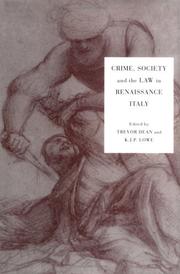
ISBN: 0521411025 0511523416 0511879601 9780521411028 9780511523410 Year: 1994 Publisher: Cambridge Cambridge University Press
Abstract | Keywords | Export | Availability | Bookmark
 Loading...
Loading...Choose an application
- Reference Manager
- EndNote
- RefWorks (Direct export to RefWorks)
Drawing on a wide body of internationally-renowned scholars, including a core of Italians, this volume focuses on new material and puts crime and disorder in Renaissance Italy firmly in its political and social context. All stages of the judicial process are addressed, from the drafting of new laws to the rounding-up of bandits. Attention is paid both to common crime and to more historically specific crimes, such as sumptuary laws. Attempts to prevent or suppress disorder in private and public life are analysed, and many different types of crime, from the sexual to the political and from the verbal to the physical, are considered. In sum the volume aims to demonstrate the fundamental importance of crime and disorder for the study of the Italian Renaissance. It is the only single-volume treatment available of the subject in English. Other books have studied crime in a single city, or single types of crime, but few have presented a cross-section of articles which deploy diverse methodological approaches in material from many parts of the peninsula.
History of the law --- History of Italy --- anno 1500-1599 --- 343 <09> <45> --- Strafwetenschappen--(geschiedenis van)--Italië --- 343 <09> <45> Strafwetenschappen--(geschiedenis van)--Italië --- -Strafwetenschappen--(geschiedenis van)--Italië --- Crime --- Renaissance --- City crime --- Crime and criminals --- Crimes --- Delinquency --- Felonies --- Misdemeanors --- Urban crime --- Social problems --- Criminal justice, Administration of --- Criminal law --- Criminals --- Criminology --- Transgression (Ethics) --- History --- Social aspects --- History. --- Italy --- Arts and Humanities --- Crime - Italy - History. --- Renaissance - Italy.
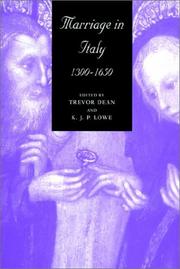
ISBN: 0521554020 0521893763 Year: 2002 Publisher: Cambridge Cambridge University Press
Abstract | Keywords | Export | Availability | Bookmark
 Loading...
Loading...Choose an application
- Reference Manager
- EndNote
- RefWorks (Direct export to RefWorks)
This volume examines four of the main areas of importance in the history of marriage: first, the wedding itself, its economics and trappings; the laws that aimed to regulate aspects of marriage; intermarriage among social groups; and, finally, the consequences of marriage for women. A number of contributions to the book set out to challenge current historical assumptions about marriage - as regards, for example, family marriage strategies or the effects of poverty and endogamy on marriage patterns in remote mountain communities. [publisher's description]
History of Italy --- anno 1600-1699 --- anno 1400-1499 --- anno 1500-1599 --- anno 1300-1399 --- Marriage --- ro: ed. by --- Married life --- Matrimony --- Nuptiality --- Wedlock --- Love --- Sacraments --- Betrothal --- Courtship --- Families --- Home --- Honeymoons --- History
Multi
ISBN: 9781107136649 9781316480045 9781316501962 1107136644 1108238904 1108239404 1108239501 1108239609 1108239706 1108240003 1108240100 1316480046 1316501965 9781108240109 9781108239509 9781108239707 9781108239400 9781108240000 9781108239608 Year: 2017 Publisher: Cambridge, United Kingdom New York, NY, USA
Abstract | Keywords | Export | Availability | Bookmark
 Loading...
Loading...Choose an application
- Reference Manager
- EndNote
- RefWorks (Direct export to RefWorks)
This invaluable collection explores the many faces of murder, and its cultural presences, across the Italian peninsula between 1350 and 1650. These shape the content in different ways: the faces of homicide range from the ordinary to the sensational, from the professional to the accidental, from the domestic to the public; while the cultural presence of homicide is revealed through new studies of sculpture, paintings, and popular literature. Dealing with a range of murders, and informed by the latest criminological research on homicide, it brings together new research by an international team of specialists on a broad range of themes: different kinds of killers (by gender, occupation, and situation); different kinds of victim (by ethnicity, gender, and status); and different kinds of evidence (legal, judicial, literary, and pictorial). It will be an indispensable resource for students of Renaissance Italy, late medieval/early modern crime and violence, and homicide studies.
History of civilization --- murders --- anno 1400-1499 --- anno 1300-1399 --- anno 1600-1699 --- anno 1500-1599 --- Italy --- Murder --- Criminal homicide --- Killing (Murder) --- History --- Homicide --- Murder - Italy - History --- Italy - History - 1268-1492 --- Italy - History - 1492-1870 --- murders [deaths] --- History.
Book
ISBN: 9781907372889 Year: 2015 Publisher: London Paul Holberton publishing
Abstract | Keywords | Export | Availability | Bookmark
 Loading...
Loading...Choose an application
- Reference Manager
- EndNote
- RefWorks (Direct export to RefWorks)
Applied arts. Arts and crafts --- Painting --- History of civilization --- decorative arts [discipline] --- influence --- easel paintings [paintings by form] --- Renaissance --- anno 1400-1499 --- anno 1500-1599 --- Lisbon --- Asia --- Africa --- cultuurgeschiedenis
Book
ISBN: 1914532007 9781914532009 9781907372889 1907372881 Year: 2015 Publisher: London
Abstract | Keywords | Export | Availability | Bookmark
 Loading...
Loading...Choose an application
- Reference Manager
- EndNote
- RefWorks (Direct export to RefWorks)
The volume highlights the unique status of Lisbon as an entrepôt for curiosities, luxury goods and wild animals. As the Portuguese trading empire of the fifteenth and sixteenth century expanded sea-routes and networks from West Africa to India and the Far East, non-European cargoes were brought back to Renaissance Lisbon. Many rarities were earmarked for the Portuguese court, but simultaneously exclusive items were readily available for sale on the Rua Nova, the Lisbon equivalent of Bond Street or Fifth Avenue. Specialized shops offered West African and Ceylonese ivories, raffia and Asian textiles, rock crystals, Ming porcelain, Chinese and Ryukyuan lacquerware, jewellery, precious stones, naturalia and exotic animal byproducts. Lisbon was also a hub of distribution for overseas goods to other courts and cities in Europe. The cross-cultural and artistic influences between Lisbon and Portuguese Africa and Asia at this date will be re-assessed --
Art objects, Renaissance --- Decorative arts, Renaissance --- History --- 1500-1599 --- Lisbon (Portugal) --- Portugal --- Lissabon. --- Portugal. --- Asien. --- Afrika. --- Description and travel --- In literature. --- Material culture --- Decorative arts, Renaissance.
Article
Abstract | Keywords | Export | Availability | Bookmark
 Loading...
Loading...Choose an application
- Reference Manager
- EndNote
- RefWorks (Direct export to RefWorks)
| Listing 1 - 10 of 15 | << page >> |
Sort by
|

 Search
Search Feedback
Feedback About UniCat
About UniCat  Help
Help News
News